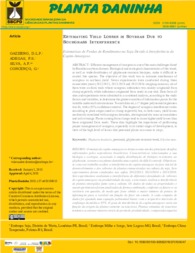Estimating yield losses in soybean due to sourgrass interference.
Estimating yield losses in soybean due to sourgrass interference.
Author(s): GAZZIERO, D. L. P.; ADEGAS, F. S.; SILVA, A. F. da; CONCENCO, G.
Summary: Efficient management of sourgrass is one of the main challenges faced by Brazilian soybean farmers. Biological and ecological characteristics of this weed, as well as wide distribution of glyphosate-resistant biotypes, make it difficult to control this species. The objective of this work was to estimate interference of sourgrass in soybean yield. Seven experiments were conducted during three consecutive years (2012/2013, 2013/2014 and 2015/2016 cropping seasons); six of them were on-farm trials where sourgrass infestation was mainly originated from clump regrowth, while infestation originated from seeds in one trial. Data from all sites and experiments were submitted to a combined analysis, according to the study factors and variables, to determine the greatest number of information points for the variable under each circumstance. To each data set, a 1st degree polynomial regression was fit, with a 95% confidence interval. The degree of sourgrass interference varies according to plant origin (seed or clump regrowth) but, in both cases, yield losses are directly correlated with sourgrass densities, aboveground dry mass accumulation and soil coverage. Plants coming from clumps tend to cause higher yield losses than those originated from seeds. These data highlight the importance of performing proper management of sourgrass, especially in its initial stages of development, in view of the high level of losses that perennial plants can cause to crops.
Publication year: 2019
Types of publication: Journal article
Unit: Embrapa Soybean
Observation
Some of Embrapa's publications are published as ePub files. To read them, use or download one of the following free software options to your computer or mobile device. Android: Google Play Books; IOS: iBooks; Windows and Linux: Calibre.
Access other publications
Access the Agricultural Research Database (BDPA) to consult Embrapa's full library collection and records.
Visit Embrapa Bookstore to purchase books and other publications sold by Embrapa.

